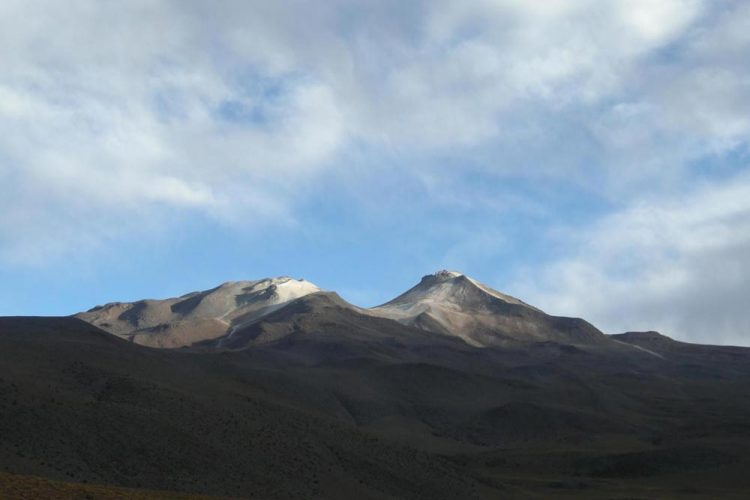Massive 'lake' discovered under volcano that could unlock why and how volcanoes erupt

Cerro Uturuncu volcano in the Bolivian Altiplano. Credit: Jon Blundy - University of Bristol
The body of water – which is dissolved into partially molten rock at a temperature of almost 1,000 degrees Celsius – is the equivalent to what is found in some of the world's giant freshwater lakes, such as Lake Superior.
The find has now led scientists to consider if similar bodies of water may be 'hiding' under other volcanoes and could help explain why and how volcanoes erupt.
Professor Jon Blundy, from the School of Earth Sciences, took part in an international multidisciplinary research project at Cerro Uturuncu volcano in the Bolivian Altiplano.
He said: “The Bolivian Altiplano has been the site of extensive volcanism over past 10 million years, although there are no currently active volcanoes there.
“The Altiplano is underlain by a large geophysical anomaly at depths of 15 km below the surface of the earth.
“This anomaly has a volume of one-and-a-half million cubic kilometres or more and is characterised by reduced seismic wave speeds and increased electrical conductivity. This indicates the presence of molten rock.
“The rock is not fully molten, but partially molten. Only about 10 to 20 percent of the rock is actually liquid; the rest is solid. The rock at these depths is at a temperature of about 970°C.”
In order to characterise the partially molten region the team performed high temperature and pressure experiments at the University of Orléans in France.
This measured the electrical conductivity of the molten rock in the 'anomalous' region and concluded that there must be about eight to ten percent of water dissolved in the silicate melt.
Professor Blundy added: “This is a large value. It agrees with estimates made for the volcanic rocks of Uturuncu using high temperature and pressure experiments to match the chemical composition of crystals.
“Silicate melt can only dissolve water at high pressure; at lower pressure this water comes out of the solution and forms bubbles. Crucially – these bubbles can drive volcanic eruptions.
“The eight to ten percent of water dissolved in the massive anomaly region amounts to a total mass of water equivalent to what is found in some of the giant freshwater lakes of North America.”
Professor Fabrice Gaillard at University of Orléans explained: “Ten per cent by weight of dissolved water means that there is one molecule of water for every three molecules of silicate. This is an extraordinarily large fraction of water, helping to explain why these silicate liquids are so electrically conductive.”
The researchers hope that better understanding of how water can trigger volcanic eruptions can improve predictions of when it is going to erupt.
Media Contact
All latest news from the category: Earth Sciences
Earth Sciences (also referred to as Geosciences), which deals with basic issues surrounding our planet, plays a vital role in the area of energy and raw materials supply.
Earth Sciences comprises subjects such as geology, geography, geological informatics, paleontology, mineralogy, petrography, crystallography, geophysics, geodesy, glaciology, cartography, photogrammetry, meteorology and seismology, early-warning systems, earthquake research and polar research.
Newest articles

Bringing bio-inspired robots to life
Nebraska researcher Eric Markvicka gets NSF CAREER Award to pursue manufacture of novel materials for soft robotics and stretchable electronics. Engineers are increasingly eager to develop robots that mimic the…

Bella moths use poison to attract mates
Scientists are closer to finding out how. Pyrrolizidine alkaloids are as bitter and toxic as they are hard to pronounce. They’re produced by several different types of plants and are…

AI tool creates ‘synthetic’ images of cells
…for enhanced microscopy analysis. Observing individual cells through microscopes can reveal a range of important cell biological phenomena that frequently play a role in human diseases, but the process of…





















